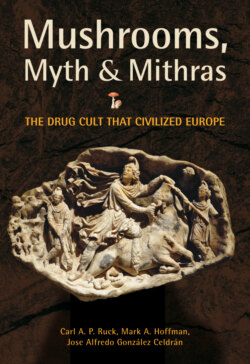Читать книгу Mushrooms, Myth and Mithras - Carl Ruck - Страница 19
На сайте Литреса книга снята с продажи.
Crossed Legs
ОглавлениеTypically their pose is nonchalant: the twin “Capped-ones” never take part in the action. They seem unable to stand on two feet, but lean with their legs crossed like the Dioskouroi to make them appear like the anthropomorphized One-foots. This perhaps also suggests the entanglement of the fiery spirit encased in the wetness of the mushroom’s spongy matter, for they are also both associated with the thunderbolt, the celestial fire, that, like the mushroom, metaphorically bellows like a bull and was commonly considered its generative force.62 Agave, the mother of Pentheus, heard the same bellowing on Mount Kithairon at the onset of her maenadic rapture in Euripides’s Bacchae. It was also the sound that Perseus heard as he confronted the Gorgon Me dusa and harvested the sacred mushroom. According to the Persians, during famine manna “sometimes falls from the heaven.” Lightning and thunder are said to be indispensable for the growth of mushrooms, which are called banat-al-ra’d in Persian, meaning “daughters of the thunder.”63 In Greek mythology, it is the “One-Eyes” called Kylopes who make the thunderbolts of Zeus.64
The land roared with the bellowing of mushrooms.
—Aristias, Perseus65
Fiery-wet mushrooms sprouting from the lightning bolt is a perfect botanical analogue for the spiritual entanglement of fire in moist matter perhaps symbolized by the crossed-legged twins. Their names denote their essential role as Torchbearers (dadaphoroi or dadouchoi in Greek), a traditional function as escorts in Mystery initiations. Inevitably, such Torchbearers would have led the candidates into the subterranean Mithraeum for the ceremonies.
Cautes is named as the “burner,” and Cautopates is similarly named, but is his twin’s superior, with the additional termination of Old Persian pat, meaning “lord.”66 Hence “Fire” and “Lord Fire” both are different aspects of Mithras himself, and recalls the Vedic Varuna-Mitra-Agni triad, where Agni is the diety of fire commonly associated with Soma. As is appropriate to his name as the joiner, Mithras himself occupies the middle between his two attendants.
That the bull secretly represents a mushroom is also indicated by the fact that Mithras sometimes is born from the rock, as in the Dura-Europos fresco, holding not a dagger, but a pruning hook or harpe (a curved sword with a straight side barb),67 and this is the implement that he will employ for the tauroctony. The harpe is an agricultural tool used to prune wild plants into a productive cultivated state.
Torchbearer Cautopates with double axe. Detail of marble statue, Sidon Mithraeum.
An axe is a more appropriate implement for slaughtering a bull. A pair of marble statues from the Sidon Mithraeum depicts the two attendants, legs uncrossed. Cautopates, identified by his down-thrust torch, wields a double axe, whose blades juxtaposed to his Phrygian cap suggests its mushroom identity.68
The prominence of the dagger-harpe in Mithraic art is significant since ordinarily the sacrificial knife had no place in the symbolism of the ritual slaughter—the actual killings were performed by persons of low social status, usually slaves. The prominence of such an implement in Mithraic iconography indicates that Mithras is not slaughtering an animal, but plucking a sacramental plant.
Even Mithras, like his squires, is a One-foot on the relief from the Saint Aubin Mithraeum as he steps out of a pile of rocks, with one foot hidden, still left behind.69
Sometimes Mithras bursts from the rock, like Atlas holding the celestial orb in his hand. This is the rock from which light descends again back to earth, for the vault of heaven was like the vaulted chamber of the Mithraeum.
